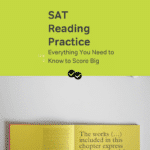Ready to try out some ACT Reading practice questions? Take a look at the following passage and the five questions (and bonus challenge question) below!
Want to make sure you’ve mastered the trickiest concepts in all areas? For ACT challenge problems from other ACT sections, check out:
HUMANITIES: This passage is adapted from the essay “Costume, Cinema, and Materiality” by Therese Andersson (Culture Unbound 3 (2011): 101-112.
The opening scene of the film Marie Antoinette (Sofia Coppola, 2006) is set in Austria: a static image of a young Marie Antoinette sleeping in a dark room. The establishing shot that follows shows Schönbrunn Palace in the early, grey morning light, before reverting to a close-up of Marie Antoinette waking up. Completely unaware of what the future has in store for her, Marie Antoinette allows the attendants to dress her just as on any other day. While she waits for them to lace the corset and finish her hair, she appears unconcerned and plays with her little pug. Dressed in a soft, velvety and lavender blue two-pieced dress, she then meets with her mother, before being sent off to France.
The theme of dressing and redressing, which is accentuated in the opening scene, is pursued throughout the film Marie Antoinette, establishing costume as a significant feature for reading the movie. Costumes help in the construction of cinematic identities. Their colors and configurations intervene with the actors’ movements, allowing further characterization on a more associative level. A character’s story is visualized through clothing. At first glance the attire of a filmic character connotes time period, social status, and whether or not the cinematic world refers to fantasy or reality. A closer examination reveals more subtle details: a character’s state of mind, motivations, and how the character wishes to be perceived.
Costume design involves conceptualizing and creating garments that capture and define the personalities of fictional characters and are therefore intended to embody the psychological, social and emotional condition of the character at a particular moment in the screenplay. For instance, one of the scenes in the “I Want Candy” montage in the film shows Marie Antoinette trying on new high-heeled shoes, and next to her on the floor lays a pair of well-worn, light blue Converse boots. The anachronistic feature is a cross-reference to today’s fashion and youth culture, reminding the audience that this is a film about teenagers and not really an 18th century period piece.
Additionally, in Marie Antoinette, color is used in a nuanced way, not only to describe the characters, but also in order to facilitate a specific look for the whole movie. On a conceptual level, the colors are used to tell a story. In this case, a story with an unhappy ending. In this early stage of Marie Antoinette’s time at Versailles, the colors worn and applied are light and icy, more sorbet-like. In the middle of the film—depicting her party years—her gowns become most dessert-like in their choice of color and even in cut, with bright yellow, pink and blue combinations creating a macaroon effect with the ornamentation of petticoats and skirts. Her dresses are modified in configuration as well and become bolder, with more daring garnish. In the final sequences of Marie Antoinette’s life at Versailles, the colors grow a bit darker, faded, and become stricter. The fabric seems to change as well, and the dresses look heavier and more formal. The whole mise-en-scène subsequently becomes darkened and the film ends with a frame of her wrecked apartment overlaid with the sound of the guillotine as it slices the air (implying Marie Antoinette’s beheading).
The color palette of the costumes might be translated to a depiction of Marie Antoinette’s inner journey. The range of colors are comparable to those of the seasons, beginning with the light, spring-like pastels for her youth; bright summer colors representing her party years; and the darker, autumn-like shades for the last period at Versailles. As such, the costumes have metaphoric meaning; they are symbols of a stage in life and a state of mind. The costumes for Marie Antoinette are thus understood as being designed in order to communicate the inner experiences of the characters.
Ultimately, costume design in Marie Antoinette allows us to quickly grasp what the characters are all about. The actual changes in French fashion that began in the 1780s are in the film used as a way to visualize Marie Antoinette’s state of mind. The costumes conspire with the other cinematic features, generating a symbolic network for telling a story through dress.
ACT Reading Practice Questions
1. The main point of the passage is that:
A. Marie Antoinette uses the symbolism of costumes more than many other films like it.
B. Costume design in Marie Antoinette allows audiences to more easily understand the psychological state of the main character.
C. Marie Antoinette’s use of anachronous costuming helps audiences today better relate to the movie’s time period.
D. Costume design in Marie Antoinette allows the audience to more easily distinguish between the personalities of the different characters.
2. According to the passage, which of the following statements is true about the film’s costumes during the “party years” of Marie Antoinette, as compared to her previous dresses?
A. They are lighter in color.
B. They are more mature.
C. They are more daring.
D. They are autumn-like in shade.
3. It can be inferred that the passage’s reference to “light blue Converse boots” is primarily intended to:
A. reveal a flaw in the cohesiveness of the film’s costume design.
B. support how costume choices can be used to reveal inner psychological conditions.
C. indicate how the film depicts various time periods through costumes.
D. provide an example of the overall light color scheme of costuming in the film.
4. The passage claims that costumes help convey all of the following about characters EXCEPT:
A. social status
B. how realistic their world is
C. historical time period
D. family relationships
5. As it is used in Paragraph 6, conspire with most nearly means:
A. scheme with
B. combine with
C. agree with
D. connive with
Answers: 1. B 2. C 3. B 4. D 5. B
ACT Reading Challenge Question
6. It can be inferred that the passage’s reference to “light blue Converse boots” is primarily intended to:
A. reveal a flaw in the cohesiveness of the film’s costume design.
B. support how costume choices can be used to reveal inner psychological conditions.
C. indicate how the film depicts various time periods through costumes.
D. provide an example of the overall light color scheme of costuming in the film.
ACT Reading Challenge Question Answer and Explanation
The answer is B. The passage says that the Converse boots “remind the audience that this is a film about teenagers and not really an 18th century piece.” From this statement, we can infer that these boots are an example of a costume choice that emphasizes inner psychological states (acting like a teenager) rather than being true to reality. Remember to always be looking for the main idea in answer choices! The main idea of this passage is exactly that: how costuming reveals inner psychological and emotional states.
ACT Reading Practice Resources
Best Free Resources for Reading Practice:
For Non-Fiction:
All of the following news magazines are available both in print and online, and they all contain interesting articles at the same reading level you could expect on ACT Reading. Practice your active reading strategies as you read (pause after each paragraph to determine the main idea, jot down the main idea of the entire piece after you finish, determine the author’s purpose in writing).
- Time Magazine
- U.S. News and World Report
(Bonus: you can find college rankings and other college-admissions related information here.) - The New Yorker
- Science Magazine
- National Geographic
- The Economist
For Fiction:
The best resource you have at your fingertips is probably whatever you are studying in English. Make sure to pay extra attention to class discussions on theme, tone, mood, and narrator’s perspective. Read the novels you may have on a shelf at home! You can also read free excerpts of books on Amazon or ebooks. Practice summarizing the narrative and determining how characters are brought to life and the relationships between characters.
Best Free Practice Tests:
You can find a full-length ACT test for free on the ACT student website along with five additional practice passages. (Make sure to check out the comparison passage, Passage 5. This is the only example out there right now from the ACT of a comparison passage!)
Although it’s not free, you should also do your best to get the Real ACT Prep Guide, which includes five official retired ACT tests. Check out your local library or school library if you can’t get a new copy. I highly recommend doing all of these tests as part of your test prep plan.






Leave a Reply